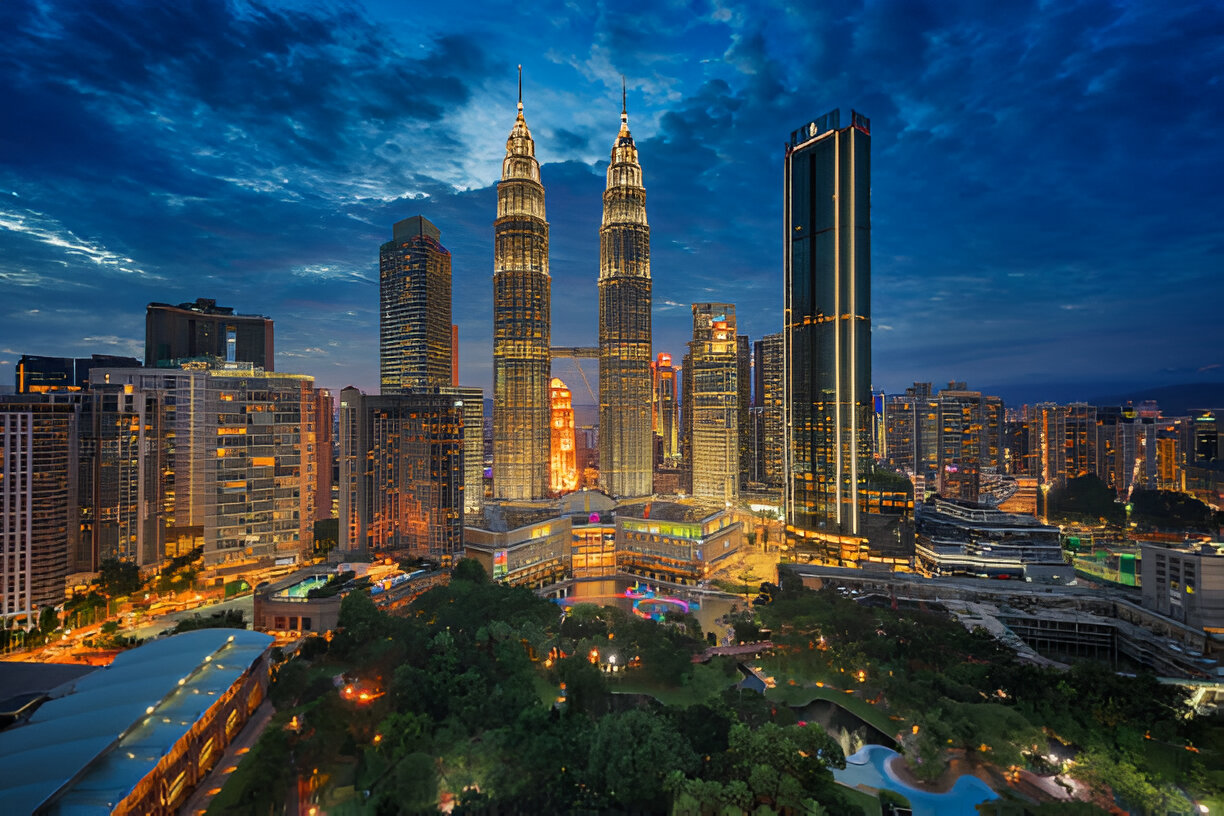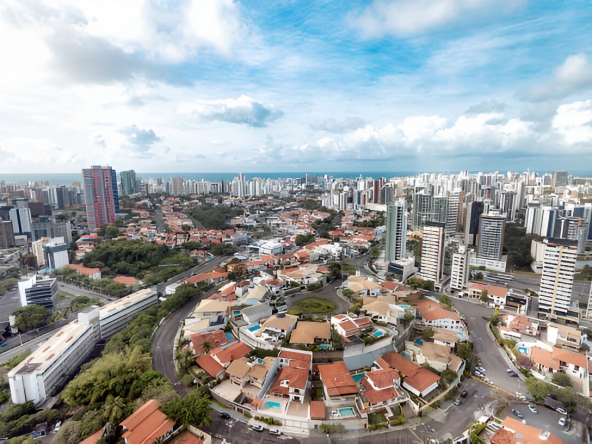Kuala Lumpur, the vibrant capital of Malaysia, is renowned for its stunning architecture that seamlessly blends historical structures with cutting-edge modern designs. As a reflection of the city’s rich cultural heritage and rapid development, the skyline is dotted with a mixture of colonial, Islamic, and contemporary buildings. From towering skyscrapers to historical landmarks, here’s a look at some of the most iconic landmarks and architectural marvels of Kuala Lumpur.
1. Petronas Twin Towers
- Location: Kuala Lumpur City Centre (KLCC)
- Year Completed: 1998
- Architectural Style: Postmodernism, Islamic Influence
No list of Kuala Lumpur’s landmarks would be complete without the iconic Petronas Twin Towers, once the tallest buildings in the world. Standing at 451.9 meters, these twin skyscrapers are the city’s defining feature and symbolize Malaysia’s rapid modernization. Designed by Argentine architect César Pelli, the towers feature an Islamic-inspired design, with eight-pointed stars and geometric patterns, reflecting Malaysia’s Muslim heritage. The sky bridge that connects the two towers at the 41st and 42nd floors offers stunning views of the city and is a must-visit for tourists.
2. Menara Kuala Lumpur (KL Tower)
- Location: Bukit Nanas
- Year Completed: 1995
- Architectural Style: Modern, Islamic Influence
The Menara Kuala Lumpur is another standout feature of KL’s skyline, standing at 421 meters tall. While primarily functioning as a communications tower, its design is inspired by Islamic motifs, with its dome resembling traditional Islamic architecture. The tower offers an observation deck with panoramic views of the city, making it a popular tourist destination. At night, the tower is beautifully illuminated, further enhancing its status as a symbol of the city’s vibrant atmosphere.
3. Sultan Abdul Samad Building
- Location: Merdeka Square
- Year Completed: 1897
- Architectural Style: Indo-Saracenic, Moorish Revival
The Sultan Abdul Samad Building is one of Kuala Lumpur’s most historic structures, representing the city’s colonial past. Built during the British colonial era, it initially housed British government offices and now serves as the offices for Malaysia’s Ministry of Information, Communications, and Culture. The building is famed for its distinctive Moorish-style architecture, with domes, arches, and a 41-meter clock tower, all set against the backdrop of Merdeka Square. Its striking copper domes and intricate design make it one of the most photographed landmarks in KL.
4. Thean Hou Temple
- Location: Robson Heights
- Year Completed: 1987
- Architectural Style: Chinese Traditional
One of the oldest and largest temples in Southeast Asia, the Thean Hou Temple is a stunning example of traditional Chinese architecture in Kuala Lumpur. Dedicated to the Chinese sea goddess Mazu, the temple is perched atop Robson Heights, offering breathtaking views of the city. The six-tiered temple features an intricate roof adorned with dragons and phoenixes, red pillars symbolizing prosperity, and a blend of Buddhist, Taoist, and Confucian elements. Its serene atmosphere makes it a popular spot for both worship and sightseeing.
5. Masjid Jamek (Jamek Mosque)
- Location: Confluence of Klang and Gombak Rivers
- Year Completed: 1909
- Architectural Style: Moorish, Mughal, Indo-Saracenic
The Masjid Jamek is one of the oldest mosques in Kuala Lumpur and remains a prominent religious site for Muslims in the city. Located at the confluence of the Klang and Gombak rivers, the mosque was designed by British architect Arthur Benison Hubback, who incorporated Mughal and Moorish architectural styles. Its striking onion-shaped domes, minarets, and arches evoke the grandeur of Mughal architecture, and its serene setting amidst the rivers adds to its peaceful ambiance. The mosque’s historical and religious significance makes it a key landmark in the heart of KL.
6. Istana Negara (National Palace)
- Location: Jalan Tuanku Abdul Halim
- Year Completed: 2011
- Architectural Style: Islamic, Malay Traditional
The new Istana Negara, or National Palace, is the official residence of the Yang di-Pertuan Agong (the King of Malaysia). The palace is a grand showcase of modern Islamic and traditional Malay architectural influences, with a golden dome and intricately designed facades. Covering 97.65 hectares, the palace features 22 domes, and its impressive scale reflects its role as a symbol of Malaysia’s monarchy. Though the interior is not open to the public, the exterior is a popular spot for visitors to catch the ceremonial changing of the guard.
7. Merdeka Square (Dataran Merdeka)
- Location: Jalan Raja
- Year Established: 1957 (Historical significance)
Though not a building, Merdeka Square is one of Kuala Lumpur’s most iconic and historically significant landmarks. It was here that Malaysia declared its independence from British rule in 1957. The square is surrounded by beautiful colonial architecture, including the Sultan Abdul Samad Building, the Royal Selangor Club, and St. Mary’s Cathedral. The 100-meter flagpole in the center of the square marks the spot where the Malaysian flag was first raised, symbolizing the country’s freedom and sovereignty.
8. National Museum (Muzium Negara)
- Location: Jalan Damansara
- Year Completed: 1963
- Architectural Style: Malay Vernacular, Minangkabau
The National Museum of Malaysia is a cultural and historical landmark that showcases the country’s rich heritage. Designed in a traditional Malay style with elements of Minangkabau architecture, the museum features a sweeping, curved roof and a facade adorned with murals that depict Malaysia’s history. Inside, visitors can explore exhibits on Malaysia’s natural history, culture, and development. The museum’s architecture, with its blend of traditional and modern elements, symbolizes Malaysia’s respect for its past while looking towards the future.
9. Masjid Negara (National Mosque of Malaysia)
- Location: Jalan Perdana
- Year Completed: 1965
- Architectural Style: Modernist Islamic
The Masjid Negara, or National Mosque of Malaysia, is a modernist take on Islamic architecture and one of the largest mosques in Southeast Asia. The mosque’s most distinctive feature is its 73-meter-high minaret and its unique star-shaped, 16-pointed roof, symbolizing the 13 states of Malaysia and the five pillars of Islam. Surrounded by serene gardens and fountains, the mosque is a peaceful sanctuary in the heart of Kuala Lumpur. It represents Malaysia’s Islamic faith while showcasing a modern architectural approach.
10. Batu Caves
- Location: Gombak, Selangor (Just outside Kuala Lumpur)
- Year Established: Over 400 million years (natural formation), Temple since 1891
- Architectural Style: Dravidian Architecture (Temple)
Just outside of Kuala Lumpur, the Batu Caves is one of the most famous Hindu religious sites in Malaysia. The limestone caves, believed to be over 400 million years old, house a series of temples and Hindu shrines, with the main cave featuring a towering golden statue of Lord Murugan, standing at 42.7 meters. The site’s vibrant Dravidian-style architecture, especially evident in the ornate temple complexes, combined with the natural beauty of the caves, makes it one of the most visited landmarks near Kuala Lumpur.
Kuala Lumpur’s architecture is a reflection of the city’s rich history, cultural diversity, and modern aspirations. From the futuristic Petronas Twin Towers to the historic Sultan Abdul Samad Building, the city’s skyline tells the story of its evolution from a small tin-mining town to a bustling metropolis. Each landmark, whether old or new, adds to the unique charm and identity of this cosmopolitan city, making Kuala Lumpur a true architectural gem of Southeast Asia.






